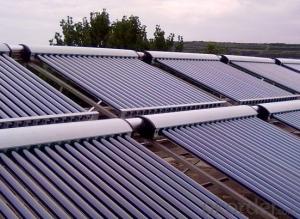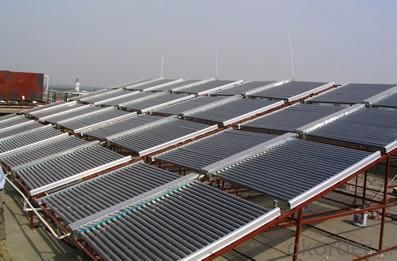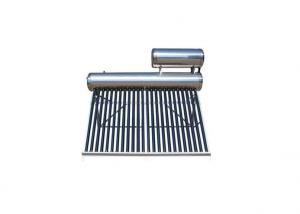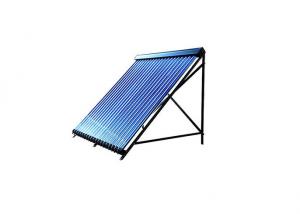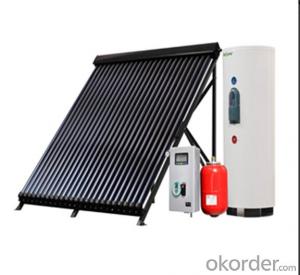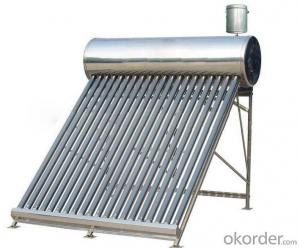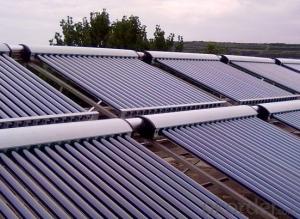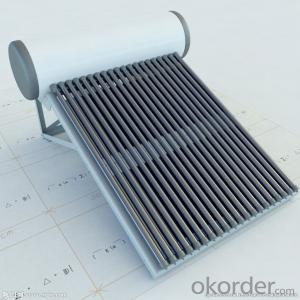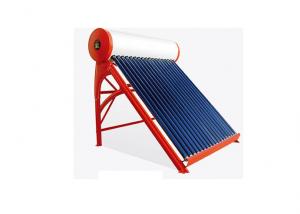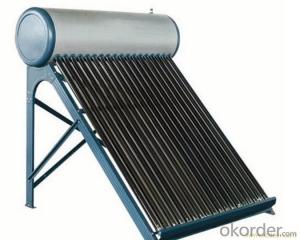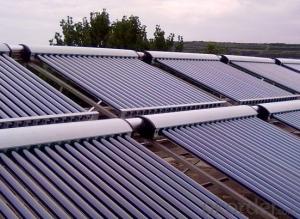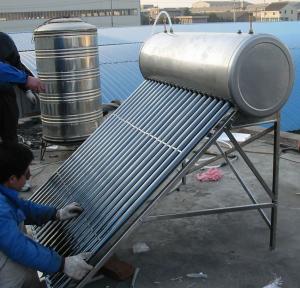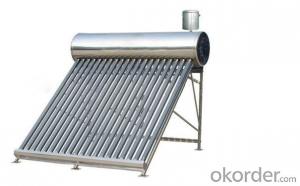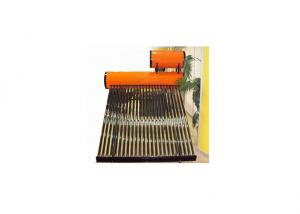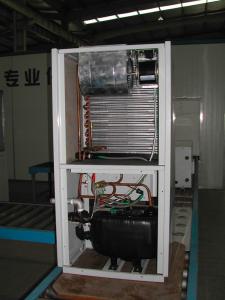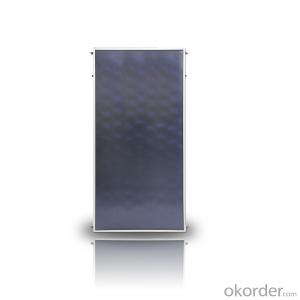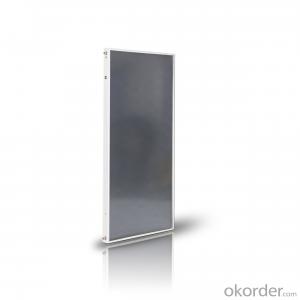Solar Water Heater Tanks - Unpressurized Vacuum Tube Solar Heater Supplier in China
- Loading Port:
- China main port
- Payment Terms:
- TT OR LC
- Min Order Qty:
- 10 set
- Supply Capability:
- 10000 set/month
OKorder Service Pledge
OKorder Financial Service
You Might Also Like
Introduction of Non-Pressure Solar Water Heater:
Non-pressure Solar Heater is one of the most economical solar water heating device with pretty high efficiency at the same time. It consists of hot water storage tank, solar vacuum tubes with mouth plug in storage tank, and bracket supporting tank and tubes.When cold water in evacuated tubes is heated with solar irradiation, as the specific gravities of hot water and cold water are different, hotter water goes upward to storage tank and colder water goes downward to glass tubes. through this continuous circulation, the cold water in storage tank will be gradually heated till sunset.
Solar water heaters working principle
1. The solar collector absorbs solar energy and transmits it to the solar water heater tank through circulation
2. When the temperature of the collector reaches the set value, the controller starts the circulation pump automatically
3. The circulation pump makes heat-conducting liquid circulate automatically
4. The heat-conducting liquid transfers heat to water by lower heat exchanger in the water tank.
5. When the temperature difference between solar collector and heat pipe solar water heaters tank doesn't reach the set value, the circulation pump will be shut automatically
6. In case the temperature of the water tank does not reach Tmax, Electric Heating Element will start to work automatically
Solar water heaters working station component:
1. Operating screen
2. Manometer
3. Pump speed adjust switches
4. Temperature difference circulation pump
5. Flow rate indicator
6. Return circuit connector
7. Safety valve
8. Expansion vessel connector9. Return circuit connector
10. Wall mounting
11. Expansion vessel:8L
12. Pressure resistance: 10 bar pressure for expansion vessel
Solar water heaters specification:
Description | solar water heaters |
Material of out manifold | 0.55mm thickness color steel/ fluorine carbon steel |
Material of inner tank | Food grade 2.0 mm thickness SUS304 stainless steel |
Tank insulating layer | 40mm 45kg/m³ high-density polyurethane foamed |
Inlet and outlet hole | Male G1'' |
Max pressure | 0.6 Mpa |
Solar collector tube | 3.3 Borosilicate glass with N/Al coating |
Thickness of glass tube | 1.6mm |
Vacuum tube tightness | P≤0.005 Pa |
Absorption | as=0.93-0.96 (AM1.5) |
Emission ratio | εh=0.04-0.06 (80C±5C) |
Idle sunning property parameters | Y=220~260m2.C/KW |
Average heat loss coefficient | ULT=0.6~0.7W/(m2.C) |
Bracket: | 2.0mm thickness aluminum alloy |
Tank weight | 75KGS |
Tank size | 560mm Dia x 1810mm Height |
Tank capacity | 300L |
Solar collector | 2pcs 58x1800x15tube solar collector |
Absorber area | 2.811 m² |
Working station | SP116 working station |
Heat exchanger length | Upper:12m, Underside:18m |
Solar water heaters details show:
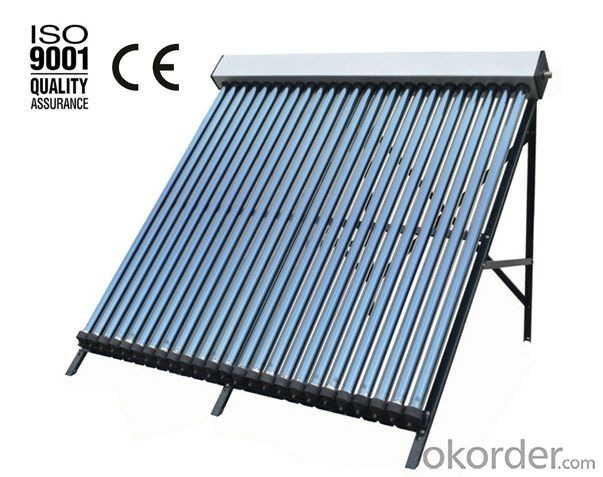

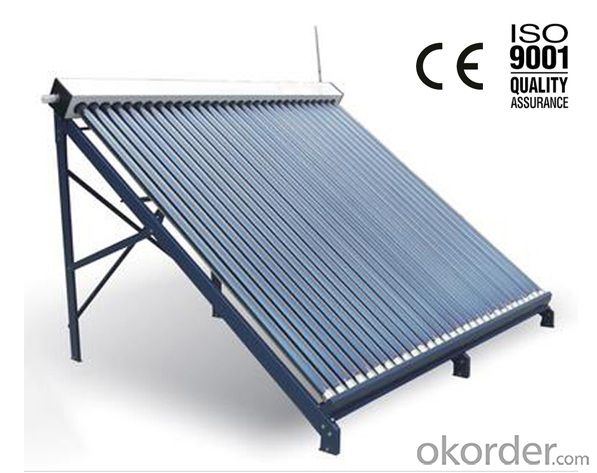
Benefits of this kind of solar water heaters:
1. Prolong the life of your existing water heater
2.Costs less than an electric, gas or oil water heater
3.No maintenance required
4.Lasts longer than a traditional hot water heater
5.Reduce your water heating costs
- Q: Can a solar water heater be used in areas with heavy snowfall?
- Yes, a solar water heater can be used in areas with heavy snowfall. However, proper installation and maintenance are crucial to ensure its efficiency. Snow accumulation on the panels can reduce their ability to absorb sunlight, so regular clearing is necessary. Additionally, installing the system at an angle and using antifreeze in the system can help prevent freezing in extreme cold temperatures.
- Q: What is the payback period for a solar water heater?
- The payback period for a solar water heater varies depending on factors such as the initial cost, energy savings, and location. On average, it can range between 2 to 7 years, but in some cases, it can be as short as 1 year or extend up to 10 years.
- Q: What are the common installation mistakes with a solar water heater?
- Some common installation mistakes with a solar water heater include improper positioning or orientation of solar panels, inadequate insulation of pipes and storage tanks, incorrect sizing of the system, poor sealing or leakage in the plumbing connections, and insufficient maintenance and monitoring of the system.
- Q: Can a solar water heater be used in areas with high levels of air pollution from natural sources (e.g., wildfires)?
- Yes, a solar water heater can still be used in areas with high levels of air pollution from natural sources like wildfires. The effectiveness of the solar water heater may be slightly reduced due to the decreased sunlight reaching the panels, but it can still provide hot water using the available sunlight. However, regular maintenance and cleaning of the panels may be required to remove any debris or soot caused by the air pollution, to ensure optimal performance.
- Q: What is the expected energy production of a solar water heater?
- The expected energy production of a solar water heater varies depending on various factors such as the size and efficiency of the system, local climate conditions, and usage patterns. On average, a well-designed solar water heater can provide around 50-80% of a household's hot water needs throughout the year.
- Q: Can a solar water heater be used in areas with limited access to wastewater treatment facilities?
- In areas lacking adequate wastewater treatment facilities, a solar water heater proves to be a suitable solution. By utilizing the sun's energy, these heaters warm water without relying on conventional energy sources, thus curbing water consumption and minimizing wastewater generation in comparison to traditional heating methods. Moreover, the energy efficiency of solar water heaters can be enhanced, consequently further reducing wastewater production. Particularly in regions where wastewater treatment facilities are scarce, this advancement alleviates strain on existing infrastructure. Furthermore, solar water heaters can be combined with other water-saving technologies, including low-flow fixtures and systems for collecting rainwater. By employing these supplementary measures, overall water usage can be diminished, resulting in a lesser requirement for extensive wastewater treatment facilities. While a solar water heater may not eradicate the necessity for wastewater treatment facilities altogether, it undeniably diminishes wastewater production significantly in areas lacking sufficient access to such amenities. This renders solar water heaters a viable and sustainable alternative for water heating in these regions.
- Q: How does a solar water heater perform during cloudy days?
- Cloudy days have a significant impact on the performance of a solar water heater. Sunlight is essential for generating heat, which warms the water in these heaters. Consequently, when clouds obscure the sun, the heat transferred to the water decreases, resulting in a decline in performance. However, it is crucial to note that solar water heaters can still function and supply hot water on cloudy days, albeit with lower efficiency. Most of these heaters are equipped with backup systems, such as electric or gas heating elements, which can be activated when there is insufficient sunlight. This ensures a continuous supply of hot water even in unfavorable weather conditions. Furthermore, advancements in technology have led to the development of more efficient solar water heaters that can still capture some solar energy even in overcast conditions. These systems utilize special coatings on solar panels or evacuated tubes to maximize heat absorption and minimize heat loss. As a result, they perform better during cloudy days compared to older models. In conclusion, although the performance of a solar water heater is diminished on cloudy days due to reduced sunlight, it is designed to provide hot water through backup systems and by utilizing any available solar energy. The efficiency of the system during cloudy days can vary depending on the design and technology employed, but newer models are more effective at capturing solar energy even in overcast conditions.
- Q: Can a solar water heater be used for industrial purposes?
- Yes, a solar water heater can be used for industrial purposes. Solar water heaters can provide a cost-effective and environmentally friendly solution for heating large volumes of water required in various industrial processes such as manufacturing, cleaning, and heating. By harnessing the energy from the sun, these systems can significantly reduce the reliance on traditional fuel sources and lower operational costs for industries while promoting sustainability.
- Q: How does the location of the solar water heater affect its performance?
- The location of a solar water heater greatly affects its performance. Ideally, it should be installed in a spot with maximum exposure to sunlight, usually on a south-facing roof. This ensures that the solar panels receive ample sunlight throughout the day, maximizing the amount of energy captured and converted into heat. Additionally, a well-placed solar water heater can minimize heat loss and reduce the need for backup heating, resulting in higher overall efficiency and cost savings.
- Q: What is the meaning of solar water heater overflow protection?
- That is, when the water is full, the water will be stopped automatically to prevent overflow. Is actually a float, float the door shut.
Send your message to us
Solar Water Heater Tanks - Unpressurized Vacuum Tube Solar Heater Supplier in China
- Loading Port:
- China main port
- Payment Terms:
- TT OR LC
- Min Order Qty:
- 10 set
- Supply Capability:
- 10000 set/month
OKorder Service Pledge
OKorder Financial Service
Similar products
Hot products
Hot Searches
Related keywords
